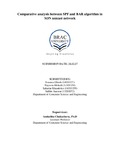| dc.contributor.advisor | Chakrabarty, Amitabha | |
| dc.contributor.author | Ghosh, Soumen | |
| dc.contributor.author | Mehedi, Nayeem | |
| dc.contributor.author | Khandoker, Sahariar | |
| dc.contributor.author | Aanwar, Sabbir | |
| dc.date.accessioned | 2018-02-20T07:05:04Z | |
| dc.date.available | 2018-02-20T07:05:04Z | |
| dc.date.copyright | 2017 | |
| dc.date.issued | 12/24/2017 | |
| dc.identifier.other | ID 14101157 | |
| dc.identifier.other | ID 14101158 | |
| dc.identifier.other | ID 14101159 | |
| dc.identifier.other | ID 13201072 | |
| dc.identifier.uri | http://hdl.handle.net/10361/9531 | |
| dc.description | Cataloged from PDF version of thesis report. | |
| dc.description | Includes bibliographical references (pages 45-47). | |
| dc.description | This thesis report is submitted in partial fulfilment of the requirements for the degree of Bachelor of Science in Computer Science and Engineering, 2017. | en_US |
| dc.description.abstract | Software Defined Networking (SDN) is a new idea of networking where Central Server takes all the decisions and finds a path for a packet to move from source to destination whereas in traditional networking a router takes decisions and finds path for the packet. The main advantage of SDN is that it reduces the time complexity of packet transfer as routers do not have to look up routing table for a path and it can reduce the packet loss to a minimum level. In traditional network, the routers make decisions according to their routing table which most of the time cannot grasp the full network topology. However, in SDN, central server possesses the entire routing table to control the data flow of network. As a result, the percentage of packet loss becomes at a minimal level. Though making packet loss zero percent cannot be achievable due to insufficient data flow path or any other physical factors, it is still less than the traditional network. In this paper, we have implemented two algorithms, Shortest Path First (SPF) and Bandwidth Aware Routing (BAR). We have simulated the algorithms in different topology using JAVA. We have noted down the packet loss, latency, path cost and bandwidth. We have developed our thesis between the comparison of Shortest Path First (SPF) and Bandwidth Aware Routing (BAR). We have simulated network graph on the both algorithms to get results of latency, bandwidth, packet loss, path cost. We hope that this comparison will help to get a clear picture about the advantages and disadvantages of these algorithms | en_US |
| dc.description.statementofresponsibility | Soumen Ghosh | |
| dc.description.statementofresponsibility | Nayeem Mehedi | |
| dc.description.statementofresponsibility | Sahariar Khandoker | |
| dc.description.statementofresponsibility | Sabbir Aanwar | |
| dc.format.extent | 47 pages | |
| dc.language.iso | en | en_US |
| dc.publisher | BRAC University | en_US |
| dc.rights | BRAC University thesis reports are protected by copyright. They may be viewed from this source for any purpose, but reproduction or distribution in any format is prohibited without written permission. | |
| dc.subject | SDN | en_US |
| dc.subject | Routing algorithm | en_US |
| dc.subject | SPF | en_US |
| dc.subject | BAR | en_US |
| dc.title | Comparative analysis between SPF and BAR algorithm in SDN unicast network | en_US |
| dc.type | Thesis | en_US |
| dc.contributor.department | Department of Computer Science and Engineering, BRAC University | |
| dc.description.degree | B. Computer Science and Engineering | |

